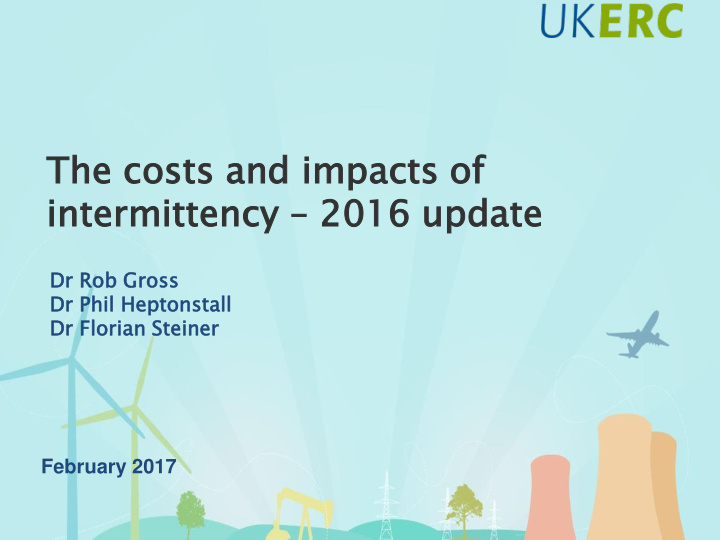



Click to add title The he cos osts ts and nd impa mpact cts s of of int ntermitt rmittenc ency y – 2016 16 up updat date Dr Rob ob Gross Dr Phil l Hept ptons onsta tall ll Dr Flor loria ian Ste tein iner er February 2017
Presentation overview Project background and research approach The research questions Reminder of findings from the 2006 report 2016 findings, by categories of impact Conclusions Q & A
Background and approach Project updates UKERC 2006 report through a systematic review of the post-2005 evidence Many countries have much more ambitious renewables targets than a decade ago Evidence drawn from academic journal papers, reports by government research labs, publicly available industry analyses Input from an Expert Group representing industry, academia, policymakers Extensive review and commentary, and peer review by international experts
Research questions What new evidence has come to light since UKERC reviewed the costs and impacts of intermittency in 2006 and what does the available evidence now suggest about the costs and impacts of intermittent generation (including relatively high penetrations of 20% and above)? What are the full range of impacts and associated costs of intermittency that are identified in the literature, and how do these impacts and costs compare to the evidence that was available in 2006? Has the reported range of impacts expanded, and if so, why? Which categories of impact are the focus of interest? To what extent is there a consensus within the current body of evidence on the size and range of the cost and impacts of intermittency?
Reminder of the 2006 report’s key findings First full meta-analysis of topic, high impact and widely cited Two major categories of impact: • System balancing – costs £2-£3/MWh* • Maintaining reliability – costs £3-£5/MWh* Most of the evidence did not look beyond 20% contribution from variable renewables Renewable resource and system characteristics key determinants of costs Other impacts very small (and much less data available) Terminology not always consistently used * In 2015 values, equivalent to approximately £2.4-£3.6/MWh and £3.6-£6/MWh respectively
Overview of 2006-2015 data A lot more data than for the 2006 project approx. 200 paper/reports 2000+ data points across eight categories of impact
Evolving methodologies As penetration levels rise, assessing system impacts becomes more complex A ‘whole system’ simulation approach is required at higher penetration levels More accurate assessment of costs but less • straightforward interpretation and presentation Separate categories of costs are not directly additive Interaction and overlap between impacts • Risk of double-counting costs • But individual cost & impact assessments still widely used…
Short term system balancing - reserve costs
Short term system balancing - reserve costs Up to a 30% penetration level, majority of results are £5/MWh or less
Short term system balancing - reserve costs At 50% penetration level, costs range between £15 and £45/MWh Up to a 30% penetration level, majority of results are £5/MWh or less
Short term system balancing - reserve costs What’s going on here? These results explore the range of flexibility and different mixes of wind and solar
Reliably meeting peak demand - capacity costs At a 30% penetration level (where wind analyses dominate) most results are £4-7/MWh
Reliably meeting peak demand - capacity costs Almost all results are less than £15/MWh, even at 50% penetration level UKERC analysis suggests that UK- relevant costs would not exceed around £14/MWh, regardless of penetration level
Understanding capacity costs – by region
Understanding capacity costs – by generation type
Understanding capacity costs – by generation type Results for PV dominate the upper and lower ends of the range, results for wind more closely grouped
Reserve and capacity costs At 30% penetration level, combined balancing and reserve costs for UK-like, wind-dominated systems look to be of the order of approx. £10/MWh - but beware of this simplification!
Curtailment
Curtailment UK and European analyses suggest that levels are very low until over 50% penetration
Curtailment What not to do - extreme outliers can result from boundary- testing model runs
Other impacts/issues Transm ansmis issio sion and d netwo etwork k cos osts: ts: up to 30% penetration level, evidence suggests that costs are in the range of £5-£20/MWh But transmission reinforcement benefits the whole system, not just • renewables Therm hermal al plant ant eff fficien iciency reductio uction: very small at low penetration levels, but can increase as penetration levels rise Imposes costs on remaining conventional generators • System em iner erti tia: a: focus is on the technical challenges rather than costs, likely to only become significant at very high instantaneous penetrations Particular issue for island systems with no/poor interconnection • Electr ectric icity ity markets: kets: significant reduction of the load factors of the remaining thermal plant on the system, and the economic value of output from intermittent generators declines as penetration levels rise
Conclusions At 30% penetration, UK-relevant balancing and reliability costs less than £10/MWh As the costs of renewables fall, system costs will become increasingly important 10 years ago, renewable costs were relatively high, system costs were small • Now, renewable costs are lower, system costs likely to be higher • Range of forecast integration costs is very wide but it is clear that flexibility is a key determinant of cost Costs for flexible systems likely to be relatively modest, costs for non- • flexible systems likely to be much higher Policy, regulation and markets must incentivise and reward flexibility If they don’t, costs may be much higher than they need to be • ‘Whole system’ analytical approach will be essential
Click to add title www.uk .uker erc. c.ac ac.uk .uk @UK UKERCHQ
Recommend
More recommend